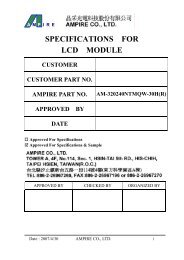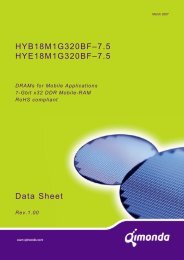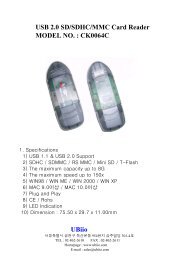Create successful ePaper yourself
Turn your PDF publications into a flip-book with our unique Google optimized e-Paper software.
Internet Data Sheet<br />
HY[B/I]18T256[40/80/16]0B[C/F](L)<br />
256-Mbit Double-Data-Rate-Two SDRAM<br />
12) The t HZ , t RPST and t LZ , t RPRE parameters are referenced to a specific voltage level, which specify when the device output is no longer driving<br />
(t HZ, t RPST ), or begins driving (t LZ, t RPRE ). t HZ and t LZ transitions occur in the same access time windows as valid data transitions.These<br />
parameters are verified by design and characterization, but not subject to production test.<br />
13) The Auto-Refresh command interval has be reduced to 3.9 µs when operating the DDR2 DRAM in a temperature range between 85 °C<br />
and 95 °C.<br />
14) 0 °C≤ T CASE ≤ 85 °C<br />
15) 85 °C < T CASE ≤ 95 °C<br />
16) A maximum of eight Auto-Refresh commands can be posted to any given DDR2 SDRAM device.<br />
17) The t RRD timing parameter depends on the page size of the DRAM organization. See Table 5 “Ordering Information for Lead-Free<br />
Products (RoHS Compliant)” on Page 6.<br />
18) The maximum limit for the t WPST parameter is not a device limit. The device operates with a greater value for this parameter, but system<br />
performance (bus turnaround) degrades accordingly.<br />
19) Minimum t WTR is two clocks when operating the DDR2-SDRAM at frequencies ≤ 200 ΜΗz.<br />
20) User can choose two different active power-down modes for additional power saving via MRS address bit A12. In “standard active powerdown<br />
mode” (MR, A12 = “0”) a fast power-down exit timing t XARD can be used. In “low active power-down mode” (MR, A12 =”1”) a slow<br />
power-down exit timing t XARDS has to be satisfied.<br />
21) WR must be programmed to fulfill the minimum requirement for the t WR timing parameter, where WR MIN [cycles] = t WR (ns)/t CK (ns) rounded<br />
up to the next integer value. t DAL = WR + (t RP /t CK ). For each of the terms, if not already an integer, round to the next highest integer. t CK<br />
refers to the application clock period. WR refers to the WR parameter stored in the MRS.<br />
TABLE 55<br />
DRAM Component Timing Parameter by Speed Grade - DDR2-400<br />
Parameter Symbol DDR2–400 Unit Notes 1)2)3)4)5)<br />
DQ output access time from CK / CK t AC –600 +600 ps<br />
CAS A to CAS B command period t CCD 2 — t CK<br />
CK, CK high-level width t CH 0.45 0.55 t CK<br />
CKE minimum high and low pulse width t CKE 3 — t CK<br />
CK, CK low-level width t CL 0.45 0.55 t CK<br />
Auto-Precharge write recovery + precharge t DAL WR + t RP — t CK<br />
7)20)<br />
time<br />
Minimum time clocks remain ON after CKE t DELAY t IS + t CK + t IH –– ns<br />
8)<br />
asynchronously drops LOW<br />
DQ and DM input hold time (differential data t DH (base) 275 –– ps<br />
9)<br />
strobe)<br />
DQ and DM input hold time (single ended data t DH1 (base) –25 — ps<br />
10)<br />
strobe)<br />
DQ and DM input pulse width (each input) t DIPW 0.35 — t CK<br />
DQS output access time from CK / CK t DQSCK –500 +500 ps<br />
DQS input low (high) pulse width (write cycle) t DQSL,H 0.35 — t CK<br />
DQS-DQ skew (for DQS & associated DQ<br />
signals)<br />
t DQSQ — 350 ps<br />
10)<br />
Min.<br />
Max.<br />
6)<br />
Write command to 1st DQS latching transition t DQSS – 0.25 + 0.25 t CK<br />
DQ and DM input setup time (differential data<br />
strobe)<br />
t DS (base) 150 — ps<br />
DQ and DM input setup time (single ended t DS1 (base) –25 — ps<br />
data strobe)<br />
10)<br />
10)<br />
<strong>Rev</strong>. <strong>1.11</strong>, 2007-07 56<br />
11172006-LBIU-F1TN



![Internet Data Sheet HYB18TC256[80/16]0BF Rev. 1.3 - UBiio](https://img.yumpu.com/50510226/1/184x260/internet-data-sheet-hyb18tc25680-160bf-rev-13-ubiio.jpg?quality=85)
![Internet Data Sheet HYS72T[32/64]xxxHP-[3S/3.7]-A Rev. 1.01 - UBiio](https://img.yumpu.com/50510224/1/184x260/internet-data-sheet-hys72t32-64xxxhp-3s-37-a-rev-101-ubiio.jpg?quality=85)

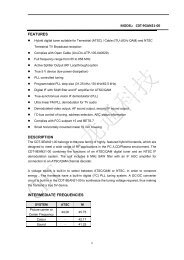
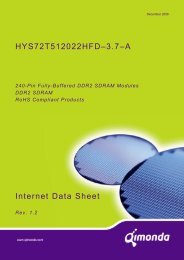

![Internet Data Sheet HY[B/I]39SC128[800/160]FE Rev. 1.1 - UBiio](https://img.yumpu.com/31629373/1/184x260/internet-data-sheet-hyb-i39sc128800-160fe-rev-11-ubiio.jpg?quality=85)
